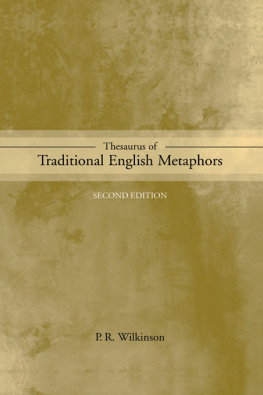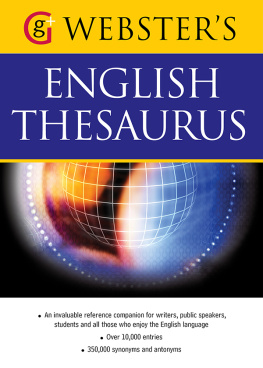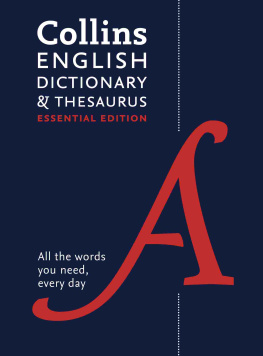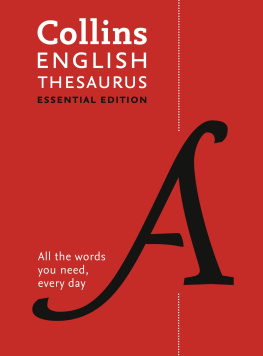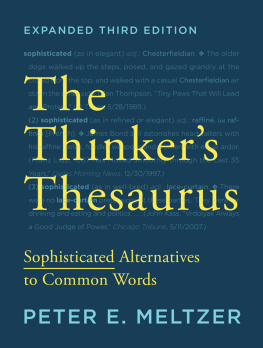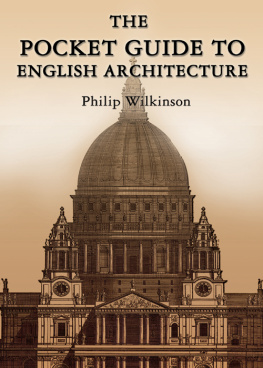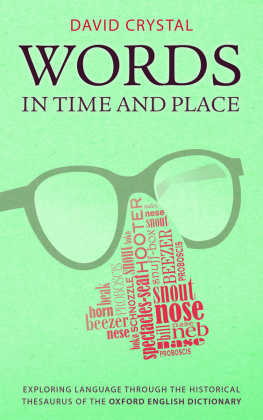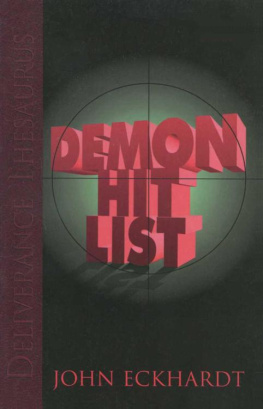P.R. Wilkinson (retail) - Thesaurus of Traditional English Metaphors
Here you can read online P.R. Wilkinson (retail) - Thesaurus of Traditional English Metaphors full text of the book (entire story) in english for free. Download pdf and epub, get meaning, cover and reviews about this ebook. publisher: Taylor and Francis;Routledge, genre: Romance novel. Description of the work, (preface) as well as reviews are available. Best literature library LitArk.com created for fans of good reading and offers a wide selection of genres:
Romance novel
Science fiction
Adventure
Detective
Science
History
Home and family
Prose
Art
Politics
Computer
Non-fiction
Religion
Business
Children
Humor
Choose a favorite category and find really read worthwhile books. Enjoy immersion in the world of imagination, feel the emotions of the characters or learn something new for yourself, make an fascinating discovery.
- Book:Thesaurus of Traditional English Metaphors
- Author:
- Publisher:Taylor and Francis;Routledge
- Genre:
- Rating:3 / 5
- Favourites:Add to favourites
- Your mark:
- 60
- 1
- 2
- 3
- 4
- 5
Thesaurus of Traditional English Metaphors: summary, description and annotation
We offer to read an annotation, description, summary or preface (depends on what the author of the book "Thesaurus of Traditional English Metaphors" wrote himself). If you haven't found the necessary information about the book — write in the comments, we will try to find it.
Thesaurus of Traditional English Metaphors — read online for free the complete book (whole text) full work
Below is the text of the book, divided by pages. System saving the place of the last page read, allows you to conveniently read the book "Thesaurus of Traditional English Metaphors" online for free, without having to search again every time where you left off. Put a bookmark, and you can go to the page where you finished reading at any time.
Font size:
Interval:
Bookmark:
 Thesaurus of TRADITIONAL ENGLISH METAPHORS Thesaurus of TRADITIONAL ENGLISH METAPHORS Second edition P.R.WILKINSON
Thesaurus of TRADITIONAL ENGLISH METAPHORS Thesaurus of TRADITIONAL ENGLISH METAPHORS Second edition P.R.WILKINSON First published 1993 by Routledge 11 New Fetter Lane, London EC4P 4EE Second edition 2002 Simultaneously published in the USA and Canada by Routledge 29 West 35th Street, New York,
First published 1993 by Routledge 11 New Fetter Lane, London EC4P 4EE Second edition 2002 Simultaneously published in the USA and Canada by Routledge 29 West 35th Street, New York,
NY 10001 Routledge is an imprint of the Taylor & Francis Group
This edition published in the Taylor & Francis e-Library, 2006.
To purchase your own copy of this or any of Taylor & Francis or Routledges collection of
thousands of eBooks please go to http://www.ebookstore.tandf.co.uk/. 2002 P.R.Wilkinson All rights reserved. No part of this book may be reprinted or reproduced or utilised in any form or
by any electronic, mechanical, or other means, now known or hereafter invented, including
photocopying and recording, or in any information storage or retrieval system, without permission
in writing from the publishers. British Library Cataloguing in Publication Data A catalogue record for this book is available from
the British Library Library of Congress Cataloging in Publication Data Wilkinson, P.R.(Peter Richard), 1926
Thesaurus of traditional English metaphors/P.R.Wilkinson. p. cm.
Includes bibliographical
references (p.) and index. 1. English language-Idioms-Dictionaries. 2. English language-Synonyms
and antonyms. 3.
Figures of speech-Dictionaries. 4. Metaphor-Dictionaries.
PE1689.W56 2002 423.1dc21 2001048566 ISBN 0-203-21985-6 Master e-book ISBN ISBN 0-203-27497-0 (Adobe e-Reader Format)
ISBN 0-415-27685-3 (Print Edition) To my wife, Joyce The greatest thing by far is to be a master of metaphor. It is the one thing that cannot be learnt; and it is also a sign of genius. [Aristotle, Poetics] CONTENTSINTRODUCTION Metaphor is a means of expressing one thing in terms of something else. It provides us with a means of understanding the way language works, from the most common phrases to the most complex linguistic theory.
Indeed much current linguistic theory ascribes to metaphor the organising principle behind all communication. In everyday life, metaphors take many different forms, including similes (a nose as red as a cherry), proverbs (dont count your chickens before theyre hatched), transfer phrases (make heavy weather of), wellerisms (everyone to his taste, as they said when the old woman kissed the cow), metonymy (the knife for surgery, the crown for royalty), synecdoches (sixty head of cattle, a cut-throat) and swearing (bloody bugger!) where the cursers feelings are expressed in terms of what might justifiably have aroused those feelings. G.K.Chesterton noted that Keats never put into a sonnet so many remote metaphors as a coster puts into a curse. Clearly, metaphorical structures are present in a multitude of daily exchanges, both verbal and written. As the main purpose of this collection is to trace the origins of folk metaphor in English, nearly all examples of metonymy, synecdoche and swearing have been omitted as being too marginal or personal. Instances of metonymy especially, because of its ephemeral, personal nature and multiplicity of applicationsthe ham-and-eggs is asking for mustardare uncollectable.
Metaphor is often used to warn or conceal from a third partyyour barn doors open. In this category are all euphemisms, but they contain the seeds of their own decay. Many good metaphors have therefore been excluded because of this inevitable ephemerality. There are also two large groups which are not admissible as true metaphors because they derive arbitrarily from sound-similarities without the necessary sense-relationship. These are based on puns like camp as a row of tents, and on rhymesplates of meat, Bristols etc. Occasionally rhyme and reason happily coincide, as in skin-and-blister=sister, but for true metaphors there must be some sense-connection, otherwise the substitute word or phrase is merely used randomly or like a secret code.
Another group of metaphors excluded are the names of natural species such as footman and emperor moths, ladys slipper, shepherds purse, porpoise etc. These are all virtual similes and are indeed ancient evidence of the nature of metaphor. Just as the megalithic builders created useful relationships out of a bewilderingly varied environment, keeping faith with the unity immanent within nature, so these name-givers, through metaphor, bore witness to the same vision of a single reality shared by human and natural communities. For this is the nature and force of metaphor: it arises only because there is a relationship to be established between two different things, and its sole function is to make the connection. In this way it reassures by bringing the unknown or the fearsome into a familiar context. Whatever particular metaphors may say, the overwhelming message of their totality is that we are all in one world and the interconnections are everywhere.
What Brown wrote about imagery is also relevant to metaphor: Imagery is a witness to the harmony between mind and matter, to the unity of all creation and thus to the oneness of its author [S.J.M. Brown, The World of Imagery]. Purely literary metaphors have been excluded, except for those which have become traditional by general acceptance, as have many Shakespearean sayings as well as titles and phrases from modern authors. Chaucerian quotations have been appended to several entries, not so much in order to ascribe their origin to him (for I understand that some, and suspect that many more, were already in everyday use when he wrote) but to show how long these images have endured in our language and how near-to-the-life he assimilated them into his poetry. Writers who have drawn on local metaphors are Sir Walter Scott, William Barnes, Thomas Hardy, Flora Thompson, Mary Webb and Hugh MacDiarmid. Other sources have been dictionaries and glossaries of dialect and folklore, collections of proverbs, similes and slang, early letters, such as the Paston, Cely and Stonor collections, and principally the common currency of everyday speech, including survivals from earlier metaphors which have now become moribund or hidden.
Any metaphor can illuminate anything else, however unlikely, and as Dr Johnson noted, metaphor gives you two ideas for one, so that every metaphor points in two directions, back to its original idea and forwards to its meaning or message. I.A.Richards called these elements the vehicle and tenor respectively. In Not a person you could creel eggs with, the vehicle is the idea of two people co-operating to fill a basket with eggs, and the tenor is the identification of someone as an unsuitable partner in such a delicate task, a rough and ready character generally, and unlikely to act with consideration for others. The metaphors in this book have been arranged by their vehicles or originating images into groups. From this another use emerges, almost as a by-product or spin-off. For just as, by extrapolating the Homeric similes from the Iliad and Odyssey, we can obtain a composite picture of daily life in Asia Minor in the ninth century BC, we can likewise conjure up the historical characters of our own ancestors by looking back to the origins of our folk metaphors.
References to the devil are predominantly jocular in tone, suggesting that many people thought of him as bogeyman rather than as a fiend actually at large. Personifications in church and graveyard were familiar from the sixteenth century on; he was the personification of evil. To preserve the memory of their ancestors, the Klinget people of Alaska erected totem poles containing their bones and an account of their deeds, but the nearest thing to a
Next pageFont size:
Interval:
Bookmark:
Similar books «Thesaurus of Traditional English Metaphors»
Look at similar books to Thesaurus of Traditional English Metaphors. We have selected literature similar in name and meaning in the hope of providing readers with more options to find new, interesting, not yet read works.
Discussion, reviews of the book Thesaurus of Traditional English Metaphors and just readers' own opinions. Leave your comments, write what you think about the work, its meaning or the main characters. Specify what exactly you liked and what you didn't like, and why you think so.

